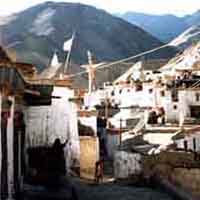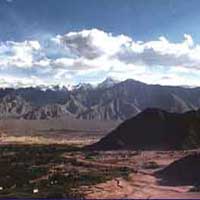|
Travelogues Great Tibetan Marathon : Hemis to Spituk
|
|||||
The race starts at the largest monastery in Ladakh, Hemis Monastery, situated on the west bank of the Indus River. It ends at Spituk Gompa, which dates back to the 11th century and is located just 8 kms from Leh. |
Factfiles • J&K Overview • Ladakh • H.P. Overview
Travelogues
Adventure | ||||
 I was still trying to get used to this high altitude cold desert with its low level of atmospheric oxygen having flown in from the plains of Delhi (216m) two days earlier. In case you are booking a flight to Leh, do try and get a window seat as this is one of the most sensational flights in the world. The plains are replaced by the white Himalayas ( Sanskrit " abode of the snows") and then by the great high altititude desert plateaus. The plane flies less than 1000 meters over some of the world's
highest mountains. Then it begins to descend into Leh and appears as if it is barely missing the high peaks on either sides.
I was still trying to get used to this high altitude cold desert with its low level of atmospheric oxygen having flown in from the plains of Delhi (216m) two days earlier. In case you are booking a flight to Leh, do try and get a window seat as this is one of the most sensational flights in the world. The plains are replaced by the white Himalayas ( Sanskrit " abode of the snows") and then by the great high altititude desert plateaus. The plane flies less than 1000 meters over some of the world's
highest mountains. Then it begins to descend into Leh and appears as if it is barely missing the high peaks on either sides.
We had dropped in to chat and have tea with friends, Chetan Mahajan and Vandita Dubey, who were running in the race. They certainly didn't seem fazed about the difficulty of the event they were to participate in a few days hence.I didn’t ask them what motivated them to run the race. Their enthusiasm for running was apparent. I remembered George Mallory’s famous line when asked why he climbed Everest. He reportedly said, "Because it is there". The morning of the Marathon appeared to be pleasant, A cool day with light clouds. But appearances can be deceptive. Temperatures reach 35 degrees Celsius (95 degrees F), and create additional problems at this 11,500 ft altitude. The Head Lama, who culd be spotted easily, blessed the runners. The race was flagged off by the erstwhile king of Ladakh. Looking for a figure in resplendent robes, my friends were having difficulty spotting the King, who was in everyday clothes. One of the most challenging marathons, there are four categories of races. 46 runners had signed up for the full marathon, while the rest participated in the half marathon and the 10 km and 5 km runs. Most of the runners have spent some two weeks hiking and running to adjust to the altitude. Some mention that they get a high just by looking at the spectacular surroundings. Runners from across the globe meet the organisers in Delhi From Delhi they fly to Leh. The following three or four days are spent acclimatising to the height and the lack of oxygen. Then comes a 3-kilometer "pleasure run" early in the morning to see how everyone is coping. On the day of the race participants wake up early and are driven 45 kilometres to the starting line at Hemis monastery. Arrival at Hemis is at 06:00, followed by the official blessing of the runners - "Race Puja" is at 06:15. There are masked monks dancing the ritual dances, fighting the demons on behalf of the runners. In the background one can hear the reverberating deep tones of several meter long brass horns. At 06:35 the half marathon runners gather to be driven out to their respective starting points along the route. At 07:00 the starting shot sounds for The Great Tibetan Marathon and at last one of the world’s hardest marathon begins! The route goes through the narrow streets and lanes of Leh city, a juxtaposition of the ancient and contemporary. After 3 hours and 44 minutes the first runner crosses the finish line at Spituk. The reward is running in one of the most beautiful and challenging landscapes in the world. As the Tibetan flags flutter in the breeze, I know they carry the message of human enthusiasm and the spirit of adventure to the gods. As one of the runners says, "I hear that there is a great race in Mongolia"
|
|||||
Editor: Romola Butalia (c) India Travelogue. All rights reserved. |
|||||
 It's hardly publicised at all. Even when we were in Leh, the capital of Ladakh, in July of 2008, there was no indication that one of the toughest marathons in the world was about to take place at Hemis, just 40 kms south of us, on Saturday the 19th of July.
It's hardly publicised at all. Even when we were in Leh, the capital of Ladakh, in July of 2008, there was no indication that one of the toughest marathons in the world was about to take place at Hemis, just 40 kms south of us, on Saturday the 19th of July.